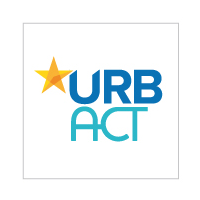The Urban Green Labs project
Edited on
27 May 2016The Urban Green Labs project set up models on how empowered civil eco-conscious groups and top down interventions can mutually reinforce each other to make cities more resilient and healthy.
By now it is clear that cities have a role in combating the impacts of ecological crisis. Urban Green Labs will tackle the issue by matching Municipalities’ physical infrastructure and public services development activities with bottom up initiatives of local communities and in the process develop new forms of governance, support eco-localism and raise the level of residents’ environmental awareness. Increasing the number of people involved will generate a critical mass to support local initiatives that improve the effectiveness of environment-friendly interventions in line with municipal strategies.

This article is based on an interview conducted by Ms Ágnes Böhönyey, Lead expert in the URBACT III Urban Green Labs network with two representatives of the Lead Partner of the project: Mr Attila Ughy, Mayor of Budapest - 18th District, and Mr István Hunyadi, city manager at the 18th District Municipality and Project Coordinator for the Urban Green Labs project.
The Urban Green Labs project was initiated by you, Mr Mayor. Please, tell us about those issues which you wanted to address in this project and why?
Attila Ughy: The 18th District is situated in the outskirts of Budapest right on the outer edge of the city’s administrative boundary. The district is mostly residential with 85% of its territory occupied by low-rise family houses and some densely populated housing estates from the socialist times, where one third of the total population lives. The diversity of the built environment is reflected in the composition of the districts population of nearly 100.000. In recent years young middle class families moved to the district because the property prices are affordable here compared to the Budapest average price and also because the district is one of the greenest of the 23 districts in Budapest. These people enjoy not only the advantage of having their own gardens but care for the wider environment: the vegetation in the surrounding streets, the nearby forest. They are also active in the community allotment and want the Municipality to establish new ones. In the past decade the Municipality focused on the rehabilitation of housing estates and worked together with the people living on the housing estates to reshape their environment. In launching the Urban Green Labs project the Municipality is going to work further with residents and the community to protect green areas and make the residential suburb even greener.
István Hunyadi: Environmental issues are high on the Municipality’s Agenda. The District Environmental Programme was endorsed by the District Council in 2008 and it has been under implementation ever since. The Municipality of 18th District joined the Covenant of Mayors movement committing itself to increasing energy efficiency and use of renewable energy sources in their territories. The Municipality developed its Sustainable Energy Action Plan. Its environmental activities are coordinated by a separate institutional unit within the Municipality lead by the Head Gardener and working with a wide range of public and private organisations, including the eco-schools in the district. The Municipality’s website has a separate page dedicated to environmental issues and providing information concerning pro-environmental thinking and activities.
AU: The Municipality’s intention is to strengthen the green image of the district. We have already been involved in two transnational projects focussing on renewable energy resources (RE-SEEties) and waste recycling (GeoSEE). There are three significant source of environmental pollution in the district which makes the Municipality determined to pursue green action in the wider sense. These are Budapest airport, the main road linking Budapest city centre with the agglomeration cutting through the district, and a 50 hectare waste disposal/landfill site. All generate serious environmental problems for the district. Long term solutions must be found in cooperation with the Capital City Centre, but in the meantime the district will work with the community to mitigate the environmental pressure.
IH: The Municipality has already acted as Lead Partner in an earlier URBACT project (Re-Block)on the rehabilitation of housing estates. This gave the opportunity for municipal officials to learn about participatory planning in practice. They experienced the advantages of involving stakeholders, especially residents, in the planning process and make them feel ownership for the jointly developed goals and action plan. In addition, the possibility of meeting and discussing with at least nine other partner cities from Europe that face similar problems helps us to learn from the experiences and successful solutions of others. This very positive experience with URBACT led the Municipality to decide to start Urban Green Lab.
What concrete results do you expect to achieve through this URBACT Action Planning Network?
AU: Several community groups and civil associations are active in the district ready to work together with the Municipality. Cooperation between civic society and the Municipality will be developed to a new level of quality. There are currently three key issues which are important for the residents, and therefore for our Municipality:
- How to protect and develop the biggest forest of Pest side (Péterhalmi erdő) situated in the 18th district for the benefit of the people living in the district
- Creating a structured green network of diverse elements within the boundaries of the district
- How to make the local farmers’ food markets successful
We also expect to learn from the good governance practices of the partners, specifically inspiring people, involving them and encouraging their interest in global and local environmental issues. Last but not least, we want to design a coherent Local Action Plan together with all relevant stakeholders which can be the basis for further municipal projects.
How did you set up your initial partnership? How do you proceed with expanding the network?
IH: First we contacted those partners who we have already had good working relations with asking them if the key issues, challenges the project addresses are relevant for them. Through the Covenant of Mayor’s network we also contacted cities with a reputation for environmental sustainability. Now we are in the process of expanding the partnership using our “reserve list” from Phase 1 and the partner list of non-selected projects in Phase 1, as well as cities who contacted us indicating that they would like to join our project. A questionnaire has already been sent out to 12 target cities with the selection criteria which we will use in selecting the partners for the Phase 2 of the Action Planning Network.
What challenges do you foresee working with partner cities?
IH: When a new project starts you have committed partners who want to achieve results together with the other partners. Very often there is a coordinator in the partner city who is like a ‘motor’ driving the project. But municipalities change and project conditions can change with it in terms of financing, personnel or the attitude towards the usefulness of transnational projects. We therefore need to maintain the initial enthusiasm throughout the project, and I am sure we will!
 Submitted by URBACT on
Submitted by URBACT on




